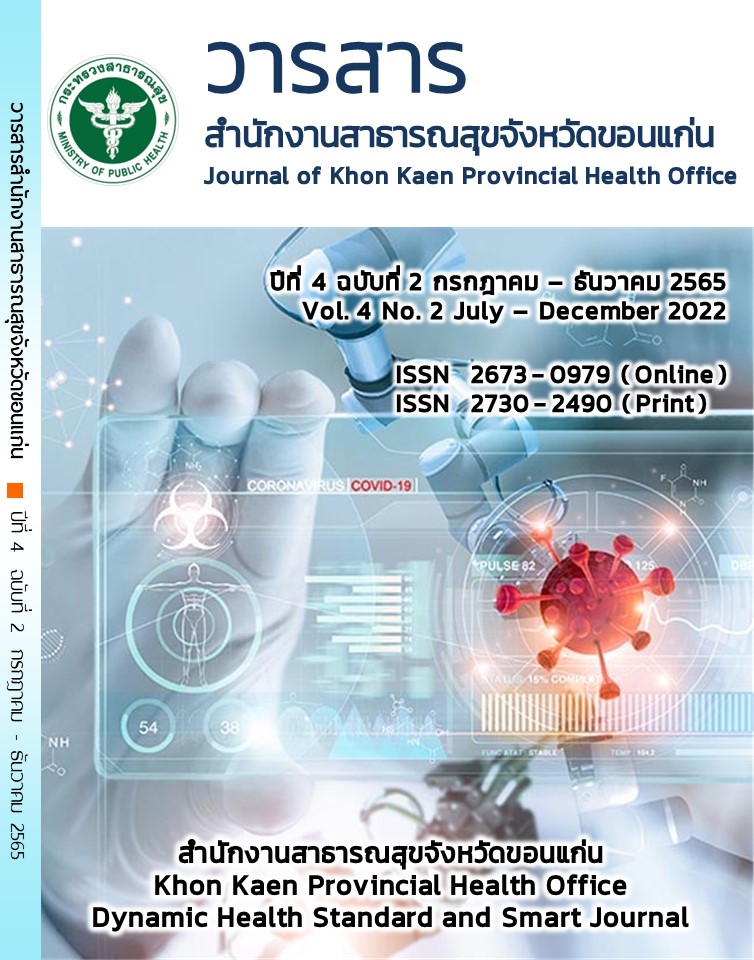ความชุกและปัจจัยที่สัมพันธ์กับภาวะการได้ยินบกพร่องในทารกแรกเกิดโรงพยาบาลสมเด็จพระยุพราชกระนวน
คำสำคัญ:
ภาวะการได้ยินบกพร่อง, ตรวจคัดกรองทารกแรกเกิด, เครื่องตรวจวัดเสียงสะท้อนจากหูชั้นในบทคัดย่อ
ภาวะการได้ยินบกพร่องพบบ่อยในเด็กทารกแรกเกิด เป็นสาเหตุสำคัญของพัฒนาการบกพร่องทั้งทางด้านการพูด ภาษา และการเรียนรู้ ภาวะนี้ไม่สามารถตรวจพบความผิดปกติได้ โดยการตรวจร่างกายทั่วไป จำเป็นต้องตรวจด้วยเครื่องตรวจวัดเสียงสะท้อนจากหูชั้นใน (Otoacoustic emission, OAE) งานวิจัยนี้จัดทำขึ้นเพื่อศึกษาความชุกและปัจจัยที่สัมพันธ์ต่อการเกิดภาวะการได้ยินบกพร่องในทารกแรกเกิดทุกรายที่คลอดที่โรงพยาบาลสมเด็จพระยุพราชกระนวน จังหวัดขอนแก่น โดยทำการศึกษาย้อนหลังเชิงพรรณนาแบบภาคตัดขวาง ดำเนินการวิจัยระหว่างวันที่ 1 กุมภาพันธ์ 2564 ถึง 31 มกราคม 2565 เก็บรวบรวมข้อมูลจากเวชระเบียนของผู้ป่วย ทารกแรกเกิดที่คลอดที่โรงพยาบาลสมเด็จพระยุพราชกระนวน โดยทารกแรกเกิดทุกรายจะได้รับ การตรวจคัดกรองการได้ยินก่อนกลับบ้านเมื่ออายุ 48 - 72 ชั่วโมง ผลวิจัย พบว่าทารกแรกเกิด ที่ได้รับการตรวจการได้ยินทั้งหมด 281 ราย มีทารกแรกเกิดที่ผลการคัดกรองการได้ยิน “ผ่าน” จำนวน 265 ราย (ร้อยละ 94.3) และมีทารกแรกเกิดที่ผลการคัดกรองการได้ยิน “ไม่ผ่าน” จำนวน 16 ราย (ร้อยละ 5.6) พบว่าภาวะติดเชื้อในกระแสเลือด (ร้อยละ 18.8 และร้อยละ 1.5 ตามลำดับ) และภาวะเลือดข้น (ร้อยละ 12.5 และร้อยละ 1.5 ตามลำดับ) เป็นปัจจัยที่มีผลต่อการตรวจคัดกรอง ไม่ผ่านอย่างมีนัยสำคัญทางสถิติ โดยมีค่า p value น้อยกว่า 0.01 และเท่ากับ 0.04 ตามลำดับ การคัดกรองภาวะการได้ยินบกพร่องในทารกแรกเกิดหลังคลอดโดยเร็วช่วยให้ค้นพบความผิดปกติและได้รับการดูแลต่อไป
เอกสารอ้างอิง
เอกสารอ้างอิง
American Academy of Pediatrics, Joint Committee on Infant Hearing. Year 2007 position statement: Principles and guidelines for early hearing detection and intervention programs. Pediatrics 007;120(4):898-921.
Davis A, Mencher G. Epidemiology of permanent childhood hearing impairment. In: Newton VE, editor. Pediatric audiological medicine. London: Whurr Publishers; 2002. p. 65-90.
Fortnum HM, Summerfield AQ, Marshall DH, Davis AC, Bamford JM. Prevalence of permanent childhood hearing impairment in the United Kingdom and implications for universal neonatal hearing screening: questionnaire-based ascertainment study. British Medical Journal. 2001;323(7312):536-40.
Wessex Universal Neonatal Hearing Screening Trial Group. Controlled trial of universal neonatal screening or early identification of permanent children hearing impairment. Lancet. 1998; 352: 1957-64.
Chareonsil R. Results of the Sawanpracharak Newborn Hearing Screening Program. ChiangMai Medical Journal 2015;54(2):81-8.
Tungvachirakul V, et al. Newborn hearing screening at Rajavithi Hospital, Thailand: hearing loss in infants not admitting in intensive care unit. J Med Assoc Thai. 2011;94 Suppl 2: S108-12.
Colella-Santos MF, Hein TA, de Souza GL, do Amaral MI, Casali RL. Newborn hearing screening and early diagnostic in the NICU. BioMed Research International. 2014; 2014:845308. doi: 10.1155/2014/845308.
Khaimook W, Chayarpham S, Dissaneevate S. The high-risk neonatal hearing screening program in Songkla nagarind Hospital. Journal of the Medical Association of Thailand. 2008;91(7): 1038-42.
Srisuparp P, Gleebbur R, Ngerncham S, Chonpracha J, Singkampong J. High-risk neonatal hearing screening program using automated screening device performed by trained nursing personnel at Siriraj Hospital: yield and feasibility. Journal of the Medical Association of Thailand. 2005; S176-82.
Kiatchoosakun P, Suphadun W, Jirapradittha J, Yimtae K, Thanawirattananit P. Incidence and risk factors associated with hearing loss in high-risk neonates in Srinagarind Hospital. Journal of the Medical Association of Thailand. 2012;95(1):52-7.
Nelson HD, Bougatsos C, Nygren P. Universal Newborn Hearing Screening: Systematic Review to Update the 2001 U.S. Preventive Services Task Force Recommendation. Pediatics 2008; 122(1): 143-148
Thompson DC, McPhillips H, Davis RL, Lieu TL, Homer CJ, Helfand M. Universal newborn hearing screening: summary of evidence. The Journal of the American Medical Association. 2001;286(16):2000-10.
Khaimook W, Chayarpham S, Dissaneevate S. The High-Risk Neonatal Hearing Screening Program in Songklanagarind Hospital. Journal of the Medical Association of Thailand. 2008; 91:1038.
World Health Organization. WHO global estimates on prevalence of hearing loss. [Online] 2021 [cited 2022 Aug 22]; Available from: https://www.who.int/news-room/fact-sheets/detail/deafness-and-hearing-loss
The Royal College of Pediatricians of Thailand & Pediatric Society of Thailand. Guideline in Child Health Supervision. [Online].2021[cited 2022 Aug 21]; Available from: https://www.thaipediatrics.org/?p=386
Chouyboonchn T,Tiravanichakul R, Mongkalanatakul N,Premkraisorn V. Newborn Hearing Screening in Ramathibodi Hospital. Ramathibodi Medical Journal.2015;38: 197-208
Oranwanich W. Neonatal Hearing Screening Program by Otoacoustic Emission at Buriram Hospital. Medical Jounal of Sisaket Surin Buriram Hospitals. 2011;26:2:285-29
Rungkarn Petluan. Incidence of Neonatal Hearing Loss by Otoacoustic Emission Screening at Takuapa Hospital. Krabi Medical Journal.2020;3:1-8
Andrea C. Wickremasinghe, Robert J. Risk of Sensorineural Hearing Loss and Bilirubin Exchange Transfusion Thresholds. PEDIATRICS September 2015; 136 (3): 505–512.
Piyawan Thongsrinuch, Sirinan Junthong. Prevalence of Early Hearing Detection and Intervention Newborn in Vajira Hospital. Vajira Medical Journal. 2021; 65 Suppl: S39-52
ดาวน์โหลด
เผยแพร่แล้ว
รูปแบบการอ้างอิง
ฉบับ
ประเภทบทความ
สัญญาอนุญาต
ลิขสิทธิ์ (c) 2022 สำนักงานสาธารณสุขจังหวัดขอนแก่น

อนุญาตภายใต้เงื่อนไข Creative Commons Attribution-NonCommercial-NoDerivatives 4.0 International License.
บทความที่ได้รับการตีพิมพ์เป็นลิขสิทธิ์ของสำนักงานสาธารณสุขจังหวัดขอนแก่น กระทรวงสาธารณสุข
ข้อความที่ปรากฏในบทความแต่ละเรื่องในวารสารวิชาการเล่มนี้เป็นความคิดเห็นส่วนตัวของผู้เขียนแต่ละท่านไม่เกี่ยวข้องกับสำนักงานสาธารณสุขจังหวัดขอนแก่น และบุคลากรท่านอื่นๆในสำนักงานฯ แต่อย่างใด ความรับผิดชอบองค์ประกอบทั้งหมดของบทความแต่ละเรื่องเป็นของผู้เขียนแต่ละท่าน หากมีความผิดพลาดใดๆ ผู้เขียนแต่ละท่านจะรับผิดชอบบทความของตนเองแต่ผู้เดียว



